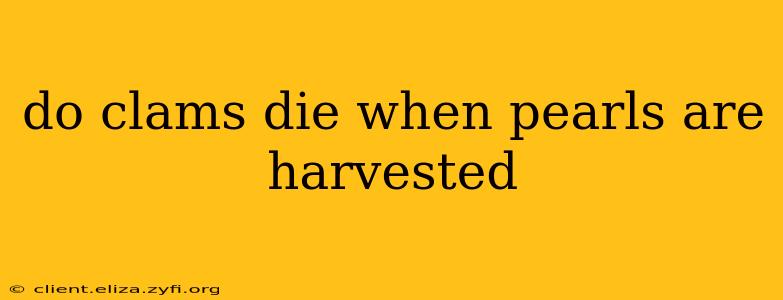The question of whether clams die when pearls are harvested is a complex one, sparking concerns about the ethics and sustainability of pearl farming. The answer, unfortunately, isn't a simple yes or no. It depends heavily on the method of pearl harvesting and the species of clam involved. Let's delve deeper into the process and explore the different scenarios.
How Are Pearls Harvested?
Pearl harvesting isn't a uniform process; it varies depending on the type of pearl and the farming practices employed. There are two main methods:
1. Natural Pearl Harvesting: This involves finding naturally formed pearls within wild oysters or clams. This process often results in the death of the mollusk, as it usually needs to be opened to remove the pearl. This method is less common due to its unsustainable nature and the rarity of finding high-quality natural pearls.
2. Cultured Pearl Harvesting: This is the dominant method in modern pearl farming. It involves inserting a nucleus (often a bead) and a piece of mantle tissue into a mollusk, which then secretes nacre around the nucleus, forming a pearl. The key here is that, in most responsible practices, the clam is not killed to harvest the cultured pearl. Instead, the pearl is carefully removed, and the mollusk is returned to the water to potentially produce more pearls in the future.
Do Clams Die During Cultured Pearl Harvesting?
The vast majority of cultured pearl farms prioritize the health and survival of the mollusks. This is vital for their business model – a dead clam yields only one pearl, while a healthy one can produce multiple over its lifetime. Therefore, experienced pearl farmers use techniques designed to minimize stress and trauma to the shellfish. This often includes:
- Specialized tools: Tools are designed to gently open the shell and extract the pearl without causing significant damage.
- Sterile conditions: Maintaining clean and sanitary conditions during the harvesting process minimizes the risk of infection.
- Careful handling: Experienced harvesters understand the delicate nature of the clams and handle them with care to prevent injury.
- Post-harvest care: After pearl extraction, the clams are carefully monitored and placed back in the water to recover.
However, it's important to acknowledge that some mortality is inevitable in any aquaculture operation. Stress from harvesting, disease, and other environmental factors can contribute to clam mortality. Responsible farms strive to minimize these losses through careful management and appropriate husbandry techniques.
What About Different Types of Clams?
The species of clam also plays a role. Some species are more resilient to the harvesting process than others. The specific techniques employed often vary based on the clam's physiology and sensitivity.
What About the Ethics of Pearl Farming?
While the industry strives for sustainability and ethical practices, concerns remain. Some consumers are hesitant to purchase pearls due to worries about animal welfare. Looking for certifications and sourcing pearls from farms with transparent and ethical practices is crucial for informed consumption.
How Can I Ensure I'm Buying Ethically Sourced Pearls?
Consumers can research pearl farms and look for certifications that demonstrate adherence to sustainable and ethical practices. Organizations dedicated to responsible aquaculture often provide information on farm certifications. Ask retailers about their sourcing practices and look for information about the origin of their pearls.
Does Pearl Harvesting Damage the Environment?
While responsible pearl farming minimizes environmental damage, some concerns remain. These include potential impacts on surrounding ecosystems and the use of chemicals or treatments in some farms. Choosing pearls from farms committed to sustainable practices is essential for minimizing environmental impact.
In conclusion, while some clams inevitably die during pearl harvesting, particularly in natural pearl harvesting, the vast majority of cultured pearls are harvested without killing the mollusk. Responsible pearl farming prioritizes the well-being of the clams to ensure their continued productivity and sustainability. However, critical consumers should still inquire about the ethical and environmental practices of the pearl farms they support.
